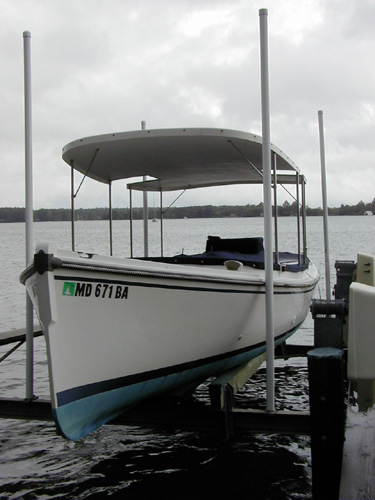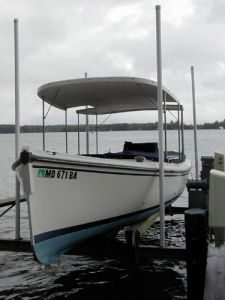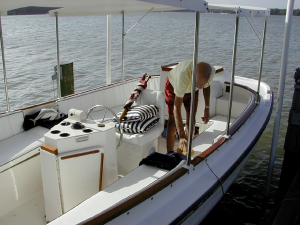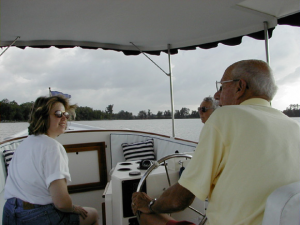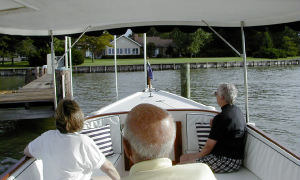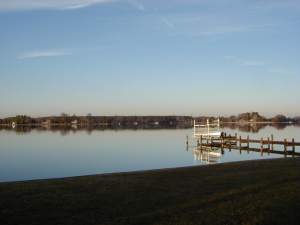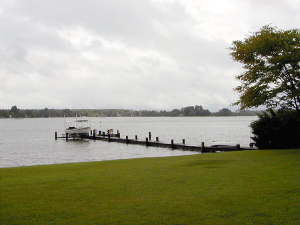Article written by my Princeton advisor, mentor, and friend:
I became a sailor rather than a powerboater because I don’t get on well with machinery. I’ve been persecuted by machinery all my life. In college, I even studied engineering in an attempt at reprisal. It didn’t work. I was particularly inept at lab experiments involving electricity, possessing an uncanny ability to dramatically shorten even the longest of circuits. Indeed, until recently, I’d never met an electron I could really buddy up to.
This awe of matters mechanical and electrical shaped my cruising habits, often to the chagrin of my family. Regardless of wind conditions, the engine was used only to enter and leave the slip. I was so stingy with electrical use that cabin lights were banned; lanterns, flashlights and, on some occasions, even candles served instead. It was a family joke that a two-birthday-candle night was a gala occasion. In view of this electrical frugality, the Dickerson Association, with whom we often cruised aboard our own Dickerson, dubbed me Captain Electron.
But inevitably there comes a time-as Dick and Dixie Goertemiller have so lucidly written about in CBM-when aging knees and sailboats no longer mix. I was able to put off contemplating the sailboating alternatives by reversing a common trend:
I actually came out of retirement and moved to Florida to take a job. Three-and-a-half years later, upon returning to Oxford, Md., it became clear to both my wife MaryAnn and me that, although future cruising would probably have to be done on other peoples’ boats, life on Trippe Creek without a boat of some sort was simply out of the question.
I had long been enamored of the steam launches from the turn of the century, with their plain, neat lines and full awnings. I gave serious thought to reproducing something of the sort, but given my mechanical talents, even I had to admit that steam engines and I would be an explosive combination, and the idea never got past cocktail conversation.
Because of my distrust of electrons, I barely considered electric propulsion. What little research I did indicated that number of small launches relied on tiny, electric trolling outboards or were too pricey. The launches I truly admired apparently came complete with wicker chairs and stewards dispensing cooling beverages on demand. Neither type seemed viable for us.
Awhile later, perusing the ads in this very magazine, I spied a picture of the launch I was after. It being the dead of winter, we were again in Florida, so the image was tucked away and almost forgotten. One day, shortly after our return to the Eastern Shore, we were having dinner at Kent Narrows when my wife, looking out the window, remarked, “There’s that boat you were looking at!”
There it was, indeed. Bearing the impressive title “Gozzard 24-CL Classic Fantail Launch,” it had everything I wanted-except the steward. It was powered by a 15-hp Honda four-stroke outboard cleverly hidden in a covered well. We inspected it after dinner and eventually purchase one.
Brought up believing that outboards were designed to get you someplace while letting everyone for miles around know exactly where that place was. I succumbed to the Gozzard’s relatively quiet charms. The addition of a boat life at the end of our dock to accommodate our new boat provided the ultimate package for bad-knees boating.It turned out to be a very satisfactory little boat. We suddenly discovered that there were all sorts of surprising coves and nooks along the Tred Avon where our Dickerson’s four-foot draft had feared to tread. We spent a delightful summer of lunch- and docktail-cruising. This would have continued again last summer had my wife not heard my niece say that she was selling her electric boat. Her what? We didn’t even know she had one. Turned out she did. Something called a Duffy 18. She invited us for a toot around St. Michaels harbor.
My wife fell in love with it instantly, as we seemed to be blowing away from the dock instead of motoring. In fact, she suggested that I “hurry up and turn on the engine.”
“It’s on, Mary Ann,” I said. “We’re currently backing under power.” Compared to the quiet Honda-powered Gozzard, this little craft was pin-drop silent. The very slight hum of a motor-cooling fan and the whisper of the belt drive were lost in the sound of the bow wave. There was even a four-speaker stereo system that provided music underway. Sailing without strings attached? This, I could appreciate.
There were a few drawbacks, of course. She was a small boat with a five-knot top speed and an eight-hour battery duration at top speed, but duration is less of an issue when you’re talking about 71-year-old bladders. Would we be satisfied with the small size and lower speed? I had a little more concern in these areas. The only way to find out was to live with them for a while. And the only way to live with them was to buy the Duffy.
Throughout the summer, I operated with no less than two launches (and how many launches, electric or otherwise, does one guy need?). The Duffy proved to be the biggest 18-foot boat I ever piloted, and the limited speed was acceptable in light of the other advantages of electricity; lack of noise, lack of fuel smells and low maintenance. We reluctantly put the beloved Gozzard up for sale with nagging doubts – if only it were electric.
Then the idea struck: We could convert the Gozzard to electric power! A letter to the builder. North Castle Marine Ltd. Of Canada, brought only a resounding silence. My next tactic involved calling Steve Black of the Eastport Electric Boat Company. This time a response came-and an enthusiastic one at that. Black undertook getting bids for installing an inboard electric-engine system. However, when they came in, the quotes were somewhat forbidding. The Gozzard remained up for sale.
Then, as we sat in Black’s office, reviewing the situation, an epiphany bloomed: We had been thinking inboard, but the Gozzard was really an outboard design, and a company by the name of Ray Electric Outboards made a motor with the strength to do what we wanted (a three-and-a-half-to-four-knot cruise speed). What’s more, Black already had one in his office!
The next weekend, armed with eight 65-pound batteries and the Ray motor, Steve arrived from Annapolis. We lashed up an experimental arrangement with the batteries on the cockpit sole and wires running all over the place. The Gozzard had always ridden low toward the stern because of the Honda’s weight and the loss of buoyancy resulting from the creation of the outboard well. We placed the batteries well forward to bring her down to her design lines. She repaid our efforts by performing beautifully, reaching our hoped-for speed with four of us aboard and handling seas better than she had in her original configuration.
It took four days to finish the job-install proper battery racks and complete the wiring-but once the work was done, it was difficult to see any difference in the boat. The motor was hidden in the well, and the batteries and wiring all fit into unused space below the seats. To our delight, everything looked as if it had been originally planned and built with electric power in mind.
Since we started the conversion to electric power so late in the season, there has been little chance to develop detailed performance data: speed versus current draw, endurance, charging times and the like. But all the indications are that we have a winner on our hands. The noise level, owing to the gear noise, while nothing compared to the Honda, is higher than that of the Duffy, but it’s readily attenuated by the wake. And then there is the possibility of employing solar cells.
I must say that some of my fear of non-wind propulsion was unjustified. Mary Ann and I have gone from all-sail all the time to all-electric. In the end, this is a tale of friendship. After all these years, I’m finally willing to shake hands with an electron. And considering my lifelong fear of the little buggers, that’s a pretty shocking development.
David Hazen is a retired professor of aeronautics from Princeton University, where he remains a professor emeritus. He lives in Oxford, Md., with his wife Mary Ann. They cruise Trippe Creek and environs aboard their electric launch, Fantastic Trippe.
– Article from Chesapeak Bay Magazine
Here is a gallery of photos from a visit to the Hazen in 1998 showing his electric boat.
Share this Post
